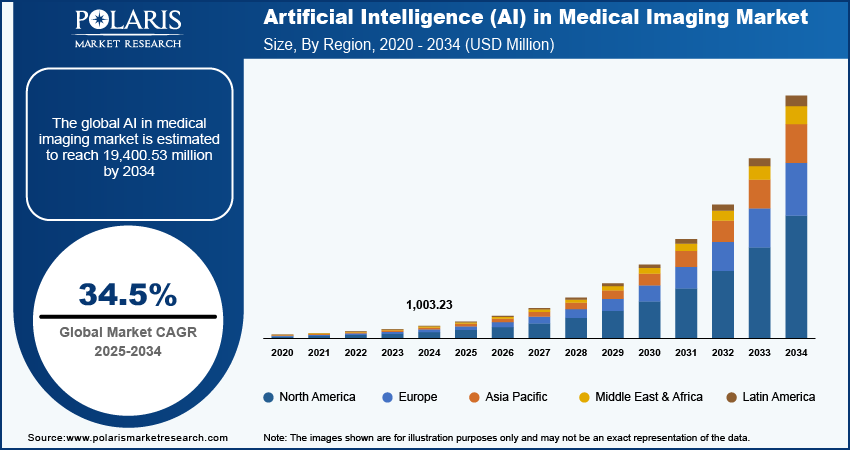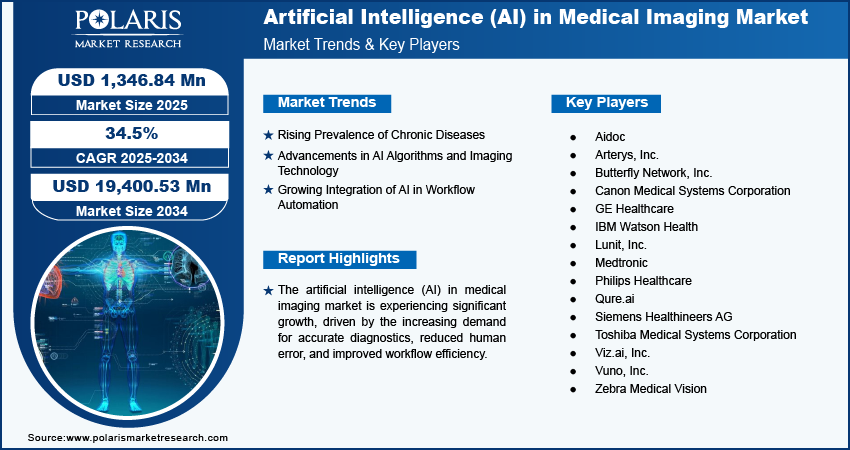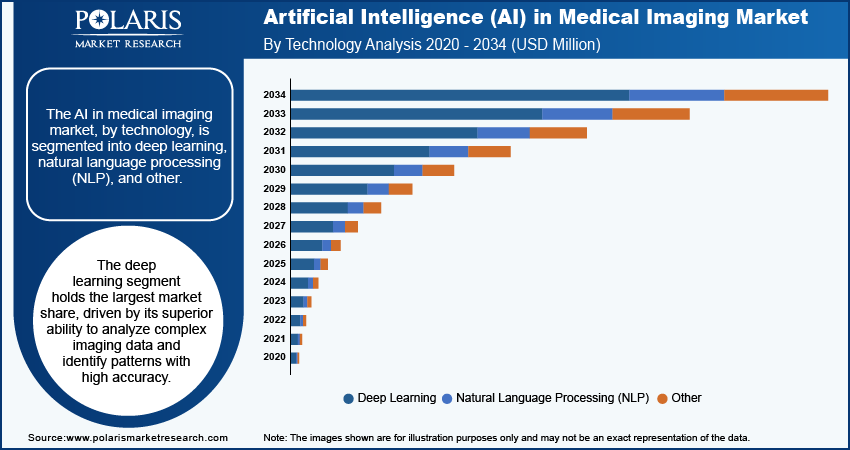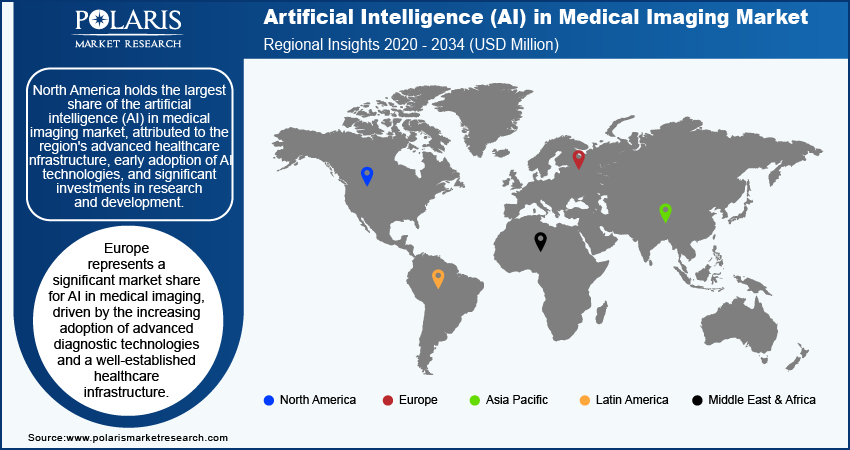
Artificial Intelligence (AI) in Medical Imaging Market Size, Share, Trends, Industry Analysis Report
: By Technology [Deep Learning, Natural Language Processing (NLP), and Other], Application, Modalities, End Use, and Region (North America, Europe, Asia Pacific, Latin America, and Middle East & Africa) – Market Forecast, 2025–2034
- Published Date:Aug-2025
- Pages: 116
- Format: PDF
- Report ID: PM4783
- Base Year: 2024
- Historical Data: 2020-2023
Market Overview
The AI in Medical Imaging market size was valued at USD 1,003.23 million in 2024, growing at a CAGR of 34.5% during 2025–2034. The rising prevalence of chronic conditions and growing AI adoption in healthcare for improving accuracy and reducing operational costs are driving market growth.
Key Insights
- The deep learning segment accounts for the largest market share, owing to its ability to analyze complex imaging data and analyze patterns with high accuracy.
- The neurology segment is poised to register the fastest growth, driven by the growing prevalence of neurological disorders.
- The CT scan segment dominates the market due to its widespread use in diagnosing several conditions.
- North America accounts for the largest market share. The presence of advanced healthcare infrastructure and significant investments in R&D drive regional market dominance.
- Asia Pacific is witnessing rapid growth. The expanding healthcare sector and growing investments in AI technologies contribute to the regional market growth.
Industry Dynamics
- The rising global burden of chronic conditions, such as cancer and neurological conditions, is boosting the adoption of AI in medical imaging.
- Continuous advancements in AI algorithms, which enable the analysis of vast datasets with high precision, is another factor fueling market expansion.
- The growing demand for AI in specialized medical imaging applications is creating several market opportunities.
- High implementation costs may hinder market growth.
Market Statistics
2024 Market Size: USD 1,003.23 million
2034 Projected Market Size: USD 19,400.53 million
CAGR (2025-2034): 34.5%
North America: Largest Market in 2024
AI Impact on Artificial Intelligence in Medical Imaging Market
- The ability of AI to enhance image clarity and reconstruction helps radiologists detect subtle abnormalities that may escape the human eye.
- Deep learning models assist in triaging scans, prioritizing urgent cases for faster clinical decision-making.
- AI-powered tools integrate imaging results with patient history. The integration supports more precise and personalized diagnoses.
- Advanced visualization and annotation systems reduce reporting time, improving efficiency and reducing diagnostic fatigue among clinicians.

The artificial intelligence in medical imaging market focuses on the integration of AI technologies, such as machine learning and deep learning, into medical imaging processes to enhance diagnosis, treatment planning, and workflow efficiency. A few key drivers of this market growth are the rising prevalence of chronic diseases, increasing demand for advanced diagnostic solutions, and the growing adoption of AI in healthcare to improve accuracy and reduce operational costs. Significant trends include the development of AI-powered imaging software, advancements in imaging equipment with embedded AI capabilities, and the growing use of cloud-based AI platforms for image analysis. Additionally, regulatory support and increasing investments in AI-driven healthcare technologies are boosting the market growth.
Market Dynamics
Rising Prevalence of Chronic Diseases
The increasing global burden of chronic diseases, such as cancer, cardiovascular disorders, and neurological conditions, is driving the adoption of AI in medical imaging. According to the World Health Organization (WHO), noncommunicable diseases account for 74% of global deaths annually. Early detection and precise diagnosis are crucial for managing these diseases effectively, and AI-enabled imaging systems offer improved accuracy in identifying anomalies compared to traditional methods. These advancements have led healthcare providers to incorporate AI technologies into their diagnostic workflows to address the growing demand for efficient and timely diagnosis. Thus, the rising prevalence of chronic diseases drives the AI in medical imaging market demand.
Advancements in AI Algorithms and Imaging Technology
Continuous advancements in AI algorithms, particularly in machine learning and deep learning, are transforming the medical imaging landscape. AI models can analyze vast datasets with high precision, identifying subtle patterns in imaging results and providing faster interpretations. Coupled with innovations in imaging technologies, such as 3D imaging and 4D imaging, AI is enabling more detailed and accurate visualization of complex anatomical structures. For example, a 2023 study published in Nature Medicine highlighted that AI-assisted breast cancer detection reduced false-negative rates by 9.4%, enhancing diagnostic reliability. These technological advancements are encouraging healthcare institutions to adopt AI-integrated imaging systems. Hence, advancements in AI algorithms and imaging technology are expected to boost the artificial intelligence in medical imaging market development in the coming years.
Growing Integration of AI in Workflow Automation
The integration of AI into medical imaging workflows is addressing critical challenges such as radiologist shortages and increasing imaging volumes. AI systems streamline operations by automating various tasks such as image acquisition, pre-screening, and generating preliminary reports. According to a 2022 survey by the American College of Radiology, over 30% of radiologists reported using AI tools to manage workloads effectively. These systems reduce diagnostic errors and allow radiologists to focus on complex cases, thereby improving overall productivity and patient outcomes. The push for operational efficiency in healthcare facilities is driving the adoption of AI-powered workflow automation in medical imaging. Therefore, the growing integration of AI in workflow automation propels the artificial intelligence in medical imaging market growth.

Segment Insights
Assessment – Technology-Based Insights
The AI in medical imaging market, by technology, is segmented into deep learning, natural language processing (NLP), and other. The deep learning segment holds the largest market share, driven by its superior ability to analyze complex imaging data and identify patterns with high accuracy. This technology is extensively utilized in detecting abnormalities, enhancing image quality, and predicting disease progression, making it indispensable in radiology and oncology. Deep learning algorithms have demonstrated significant advancements in precision diagnostics, as evidenced by their application in breast cancer screening, where studies report enhanced detection rates and reduced false positives. The widespread adoption of deep learning is further supported by its integration into advanced imaging modalities, such as CT and MRI, and its capability to handle large datasets efficiently.
The natural language processing (NLP) segment is registering the highest growth, attributed to its ability to extract actionable insights from unstructured clinical data, including radiology reports and medical records. NLP is increasingly used to streamline reporting workflows, automate annotations, and improve decision-making processes in medical imaging. For instance, NLP in healthcare and life sciences tools are being employed to generate real-time diagnostic summaries, enhancing collaboration between radiologists and clinicians. Additionally, the adoption of NLP solutions in telemedicine and remote healthcare settings is contributing to its rapid growth, as these technologies enable seamless communication and data sharing across healthcare networks.
Outlook – Application-Based Insights
The artificial intelligence in medical imaging market, by application, is segmented into neurology, respiratory & pulmonary, cardiology, breast screening, orthopedics, and others. The breast screening segment holds the largest share of the AI in medical imaging market revenue, primarily due to the rising prevalence of breast cancer and the growing emphasis on early detection and screening programs. AI technologies are widely integrated into mammography systems to improve the accuracy of breast cancer detection, reduce false positives, and assist radiologists in identifying subtle abnormalities. According to the World Health Organization (WHO), breast cancer is the most common cancer among women globally, with over 2.3 million cases diagnosed annually. The widespread adoption of AI-based breast screening solutions is further propelled by government initiatives and public awareness campaigns promoting regular screenings.
The neurology segment is experiencing the highest growth, driven by the increasing prevalence of neurological disorders such as Alzheimer’s disease, stroke, and epilepsy. AI applications in neurology focus on advanced imaging techniques, such as MRI and CT, to enhance the detection and monitoring of brain anomalies. These technologies are also being utilized to predict disease progression and assist in surgical planning. For example, AI-powered tools are helping healthcare providers identify ischemic strokes more accurately and rapidly, thereby improving patient outcomes. The growing demand for precision diagnostics in neurology, coupled with advancements in AI algorithms tailored for brain imaging, is fueling this segment's rapid expansion.
Evaluation – Modalities-Based Insights
The artificial intelligence in medical imaging market, by modalities, is segmented into CT scan, MRI, X-rays, ultrasound, and nuclear imaging. The CT scan segment holds the largest market share, primarily due to its widespread use in diagnosing a variety of conditions, including trauma, cancer, and cardiovascular diseases. AI technologies are increasingly integrated into CT imaging systems to enhance image reconstruction, reduce scan times, and improve diagnostic accuracy. These advancements are particularly valuable in emergency settings, where rapid and precise diagnostic insights are critical. The segment's dominance is further supported by the growing adoption of AI-powered CT imaging in detecting early-stage diseases and its ability to process large volumes of imaging data efficiently.
The ultrasound segment is registering the highest growth, driven by its expanding applications in areas such as obstetrics, cardiology, and point-of-care diagnostics. AI integration in ultrasound imaging has revolutionized workflow efficiency by automating image acquisition and interpretation processes. For example, AI-powered tools are enabling real-time, automated measurements of fetal development and cardiovascular functions, reducing operator dependency. Additionally, the portability and cost-effectiveness of AI-enabled handheld ultrasound devices are accelerating adoption, particularly in resource-constrained settings and telemedicine applications. These factors are driving the rapid growth of the ultrasound segment in the AI in medical imaging market.
Assessment – End Use-Based Insights
The AI in medical imaging market, by end use, is segmented into hospitals, diagnostic imaging centers, and others. The hospital segment dominates the artificial intelligence in medical imaging market share, driven by the high volume of imaging procedures performed and the availability of advanced healthcare infrastructure. Hospitals are increasingly adopting AI-powered imaging solutions to enhance diagnostic accuracy, streamline workflows, and manage the growing demand for imaging services. Additionally, the integration of AI technologies into hospital systems facilitates faster decision-making and improved patient outcomes. Government initiatives to equip public hospitals with advanced diagnostic tools and the presence of skilled professionals further contribute to this segment's dominance.
The diagnostic imaging centers segment is experiencing the highest growth, fueled by their focus on providing specialized imaging services and adopting innovative AI solutions to enhance operational efficiency. These centers are leveraging AI technologies to offer faster and more accurate diagnostics, attracting a broader patient base. The demand for outpatient imaging services, coupled with the rising prevalence of chronic diseases, is encouraging diagnostic centers to invest in AI-powered modalities. Furthermore, the increasing preference for standalone imaging facilities due to shorter waiting times and cost-effective services is accelerating the growth of this segment in the market.

Regional Insights
By region, the study provides artificial intelligence in medical imaging market insights into North America, Europe, Asia Pacific, Latin America, and the Middle East & Africa. North America holds the largest share of the market, attributed to the region's advanced healthcare infrastructure, early adoption of AI technologies, and significant investments in research and development. The presence of leading AI solution providers and a high prevalence of chronic diseases, such as cancer and cardiovascular disorders, further drive market growth in the region. Favorable regulatory frameworks and initiatives, such as the FDA's support for AI-based medical devices, have also encouraged the integration of AI into medical imaging workflows. Additionally, strong collaboration between healthcare institutions and technology companies in North America enhances the deployment of innovative AI solutions, solidifying the region's leadership in the market.
Europe represents a significant market for artificial intelligence (AI) in medical imaging, driven by the increasing adoption of advanced diagnostic technologies and a well-established healthcare infrastructure. The region benefits from strong government support and funding initiatives aimed at integrating AI into healthcare systems. Countries such as Germany, the UK, and France are at the forefront, leveraging AI for precision diagnostics and workflow optimization. Additionally, the growing focus on reducing healthcare costs and improving patient outcomes has encouraged the adoption of AI-enabled imaging solutions across public and private healthcare institutions.
The Asia Pacific AI in medical imaging market is experiencing rapid growth, fueled by the expanding healthcare sector, rising prevalence of chronic diseases, and increasing investments in AI technologies. Countries such as China, Japan, and India are leading the region's adoption of AI, supported by advancements in healthcare infrastructure and government initiatives to promote AI-driven innovations. The growing demand for affordable diagnostic solutions in rural and underserved areas is also driving the development of AI-powered portable imaging devices, further boosting the artificial intelligence in medical imaging market expansion in the region.

Key Players and Competitive Insights
A few key players in the artificial intelligence in medical imaging market include Siemens Healthineers AG; GE Healthcare; Philips Healthcare; IBM Watson Health; Medtronic; Canon Medical Systems Corporation; Toshiba Medical Systems Corporation; Butterfly Network, Inc.; Zebra Medical Vision; Vuno, Inc.; Arterys, Inc.; Aidoc; Lunit, Inc.; Qure.ai; and Viz.ai, Inc. These companies are actively engaged in developing AI solutions for medical imaging, providing a range of products such as AI-powered diagnostic tools, imaging software, and advanced imaging systems. They continue to innovate and expand their market presence, focusing on integrating AI into radiology, oncology, cardiology, and neurology imaging applications.
The competitive landscape of the AI in medical imaging market is characterized by the strong presence of established companies with extensive research and development capabilities. Siemens Healthineers AG and GE Healthcare continue to dominate the market, investing in AI-powered imaging systems that enhance diagnostic accuracy and workflow efficiency. Additionally, smaller firms such as Aidoc and Qure.ai are gaining traction with their specialized AI solutions, providing radiologists with tools for faster and more accurate diagnoses. These companies are increasingly focusing on partnerships and collaborations with healthcare providers to enhance their product offerings and reach broader markets.
While large corporations lead in terms of technological advancements and infrastructure, smaller companies are contributing to the market growth by offering innovative and specialized solutions in areas such as radiology and cardiology. The competitive dynamics in the AI medical imaging space are also shaped by the increasing role of software-driven solutions and cloud platforms, with companies such as Arterys, Inc. and Lunit, Inc. capitalizing on the growing demand for cloud-based AI applications. As AI continues to gain acceptance in medical imaging, market players are focusing on improving the speed, accuracy, and accessibility of diagnostic imaging services, creating a more competitive and evolving landscape.
Siemens Healthineers AG, a global company specializing in medical technology, offers a range of products and services, including imaging systems, laboratory diagnostics, and point-of-care testing. They focus on developing technologies to improve patient care and streamline healthcare processes.
GE HealthCare is a company that provides medical imaging equipment, monitoring systems, and diagnostic technologies. They aim to support healthcare professionals in delivering quality care through their products and services.
List of Key Companies
- Aidoc
- Arterys, Inc.
- Butterfly Network, Inc.
- Canon Medical Systems Corporation
- GE Healthcare
- IBM Watson Health
- Lunit, Inc.
- Medtronic
- Philips Healthcare
- Qure.ai
- Siemens Healthineers AG
- Toshiba Medical Systems Corporation
- Viz.ai, Inc.
- Vuno, Inc.
- Zebra Medical Vision
Artificial Intelligence (AI) in Medical Imaging Industry Developments
- In December 2024, Siemens Healthineers introduced the AI Abdomen feature as part of their Acuson Sequoia 3.5 Ultrasound system. This feature automatically labels and measures organs in milliseconds, aiming to enhance standardization and reduce false negatives in abdominal imaging.
- In December 2024, GE HealthCare announced plans to release its financial results for the fourth quarter and full year 2024 on February 13, 2025. This announcement reflects the company's ongoing commitment to transparency and financial reporting.
Artificial Intelligence (AI) in Medical Imaging Market Segmentation
By Technology Outlook
- Deep Learning
- Natural Language Processing (NLP)
- Other
By Application Outlook
- Neurology
- Respiratory & Pulmonary
- Cardiology
- Breast Screening
- Orthopedics
- Others
By Modalities Outlook
- CT Scan
- MRI
- X-rays
- Ultrasound
- Nuclear Imaging
By End Use Outlook
- Hospitals
- Diagnostic Imaging Centers
- Others
By Regional Outlook
- North America
- US
- Canada
- Europe
- Germany
- France
- UK
- Italy
- Spain
- Netherlands
- Russia
- Rest of Europe
- Asia Pacific
- China
- Japan
- India
- Malaysia
- South Korea
- Indonesia
- Australia
- Vietnam
- Rest of Asia Pacific
- Middle East & Africa
- Saudi Arabia
- UAE
- Israel
- South Africa
- Rest of Middle East & Africa
- Latin America
- Mexico
- Brazil
- Argentina
- Rest of Latin America
Artificial Intelligence (AI) in Medical Imaging Market Report Scope
|
Report Attributes |
Details |
|
Market Size Value in 2024 |
USD 1,003.23 million |
|
Market Size Value in 2025 |
USD 1,346.84 million |
|
Revenue Forecast by 2034 |
USD 19,400.53 million |
|
CAGR |
34.5% from 2025 to 2034 |
|
Base Year |
2024 |
|
Historical Data |
2020–2023 |
|
Forecast Period |
2025–2034 |
|
Quantitative Units |
Revenue in USD million and CAGR from 2025 to 2034 |
|
Report Coverage |
Revenue Forecast, Market Competitive Landscape, Growth Factors, and Trends |
|
Segments Covered |
|
|
Regional Scope |
|
|
Competitive Landscape |
|
|
Report Format |
|
|
Customization |
Report customization as per your requirements with respect to countries, regions, and segmentation. |
How is the report valuable for an organization?
Workflow/Innovation Strategy
The AI in medical imaging market has been segmented into detailed segments of technology, application, modalities, and end use. Moreover, the study provides the reader with a detailed understanding of the different segments at both the global and regional levels.
Growth/Marketing Strategy
The artificial intelligence (AI) in medical imaging market growth and marketing strategy is focused on continuous innovation, strategic partnerships, and expanding customer bases. Companies are investing heavily in research and development to create advanced AI algorithms that improve diagnostic accuracy and operational efficiency. Collaborations with healthcare providers, research institutions, and technology firms are key to driving the adoption and integration of AI solutions in medical imaging. Additionally, companies are focusing on expanding their presence in emerging markets by offering cost-effective solutions and enhancing product accessibility through cloud-based platforms and portable devices. Marketing efforts are concentrated on educating healthcare professionals about the benefits of AI in improving patient outcomes and workflow optimization.
FAQ's
The artificial intelligence (AI) in medical imaging market size was valued at USD 1,003.23 million in 2024 and is projected to grow to USD 19,400.53 million by 2034.
The market is projected to register a CAGR of 34.5% during the forecast period.
North America had the largest share of the market in 2024.
A few key players in the market are Siemens Healthineers AG; GE Healthcare; Philips Healthcare; IBM Watson Health; Medtronic; Canon Medical Systems Corporation; Toshiba Medical Systems Corporation; Butterfly Network, Inc.; Zebra Medical Vision; Vuno, Inc.; Arterys, Inc.; Aidoc; Lunit, Inc.; Qure.ai; and Viz.ai, Inc.
The deep learning segment held the largest market share in 2024.
The breast screening segment held the largest share of the AI in medical imaging market revenue in 2024.
Artificial intelligence (AI) in medical imaging refers to the use of machine learning, deep learning, and other AI technologies to enhance the analysis, interpretation, and processing of medical images. AI systems are designed to assist healthcare professionals in diagnosing and treating various conditions by providing faster, more accurate results. These technologies can identify patterns, detect abnormalities, and even predict disease progression from medical imaging data, such as X-rays, MRIs, CT scans, and ultrasounds. AI in medical imaging aims to improve diagnostic accuracy, reduce human error, enhance workflow efficiency, and enable earlier detection of diseases, ultimately contributing to better patient outcomes.
A few key trends in the market are described below: Integration of AI in Radiology Workflows: Increasing adoption of AI technologies to streamline workflows, automate routine tasks, and improve efficiency in radiology departments. AI-Powered Diagnostic Tools: Development of AI-driven solutions to assist in diagnosing a wide range of diseases, such as cancer, neurological disorders, and cardiovascular conditions. Cloud-Based AI Solutions: Growing preference for cloud platforms that enable scalable and accessible AI tools for remote diagnosis and collaboration. Personalized Medicine: AI's role in tailoring treatments based on specific patient data and imaging results, improving the precision of care.
A new company entering the artificial intelligence in medical imaging market should focus on developing AI solutions that enhance real-time diagnostics and automate workflows to improve efficiency for healthcare providers. Emphasizing the integration of AI with cloud-based platforms can offer scalability and accessibility, making solutions more cost-effective and attractive to hospitals and diagnostic centers. Additionally, targeting emerging markets with portable, affordable AI imaging devices can help the company expand its reach. Focusing on niche applications, such as early disease detection or personalized medicine, can also differentiate the company from competitors and address specific healthcare needs. Furthermore, forging partnerships with established healthcare providers and regulatory bodies will ensure faster adoption and credibility in the market.
Companies manufacturing, distributing, or purchasing AI-integrated medical imaging equipment and related products, and other consulting firms must buy the report.
